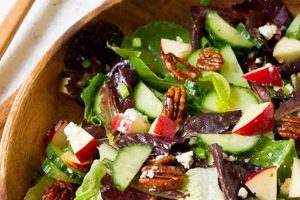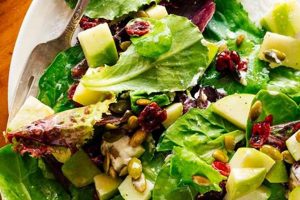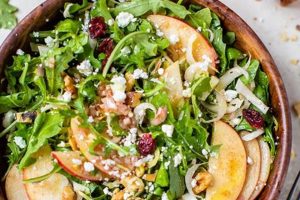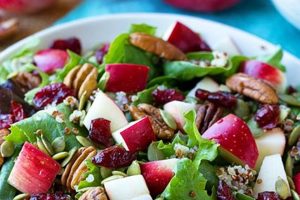This refreshing dish typically combines tart cranberries, sweet apples, and jiggly gelatin, often with additions like chopped walnuts or pecans, celery, or cream cheese. Variations abound, offering cooks flexibility in flavor profiles and textures, from a simple molded dessert to a more complex layered creation. It showcases the versatility of gelatin as a binder and the complementary nature of fruit and nut combinations.
A staple at holiday gatherings and potlucks, particularly in North America, this type of salad provides a light, palate-cleansing contrast to richer dishes. Its popularity likely stems from its ease of preparation, affordability, and make-ahead convenience. Historically, gelatin-based dishes gained traction as a symbol of modernity and sophistication in the early 20th century, coinciding with the rise of commercially available gelatin products. The combination of fruit and nuts within these salads provided a balance of flavors and textures appreciated across generations.
The following sections delve further into variations, ingredient selection, preparation techniques, and tips for presentation, empowering readers to create their own perfect version of this classic dish. From selecting the right apples and cranberries to mastering the art of layering and molding, these insights will provide the knowledge and confidence to impress guests with both taste and visual appeal.
Tips for Success
Achieving optimal results requires attention to detail and a few key considerations. The following tips provide guidance for creating a dish that is both visually appealing and delicious.
Tip 1: Apple Selection: Opt for firm, tart apple varieties like Granny Smith or Honeycrisp. These hold their shape well and provide a pleasant contrast to the sweetness of the other ingredients. Avoid overly ripe or mealy apples, as these can disintegrate during preparation.
Tip 2: Cranberry Preparation: Fresh or frozen cranberries can be used. If using fresh cranberries, a light chop or pulse in a food processor can improve texture and distribute flavor evenly. Frozen cranberries should be thawed and drained before incorporating.
Tip 3: Gelatin Bloom: Allowing the gelatin to bloom in cold water before dissolving ensures proper setting and a smooth texture. Follow package instructions for specific blooming times.
Tip 4: Layering for Visual Appeal: Creating distinct layers of apples, cranberries, and nuts elevates the presentation. Chill each layer thoroughly before adding the next to prevent mixing.
Tip 5: Mold Selection: Consider using decorative molds for festive occasions. Bundt pans, ring molds, or individual serving dishes can enhance visual appeal. Ensure the mold is lightly greased or sprayed with cooking spray for easy removal.
Tip 6: Unmolding Technique: To unmold, briefly dip the mold in warm water, being careful not to submerge it completely. Invert onto a serving platter and gently shake to release.
Tip 7: Flavor Enhancements: Orange zest, a splash of orange juice, or a pinch of cinnamon can complement the existing flavors and add complexity.
By following these tips, one can ensure a successful outcome, resulting in a delightful and visually appealing dish that complements any meal.
These techniques and considerations pave the way for a culinary creation that is both satisfying and impressive.
1. Ingredients
Ingredient selection significantly impacts the final quality, flavor profile, and textural complexity of a cranberry apple jello salad. Careful consideration of each component ensures a balanced and enjoyable dish. The following facets highlight the essential ingredients and their roles.
- Cranberries:
Cranberries provide the tart counterpoint to the sweetness of the apples and sugar. Fresh or frozen cranberries can be used; each offers a slightly different texture. Fresh cranberries provide a slightly firmer bite, while frozen cranberries, once thawed, integrate more readily into the gelatin matrix. The quantity of cranberries influences the overall tartness of the salad.
- Apples:
Apples contribute sweetness and textural contrast. Firm, tart varieties such as Granny Smith or Honeycrisp are preferred as they hold their shape well during preparation and offer a complementary flavor profile. Sweeter varieties like Fuji or Gala can also be used, but may require adjustments to the sugar content to balance the overall sweetness.
- Gelatin:
Gelatin acts as the binding agent, giving the salad its characteristic jiggly texture. Unflavored gelatin is typically used, allowing the fruit flavors to dominate. The amount of gelatin used influences the firmness of the final product. Proper blooming of the gelatin granules in cold water before dissolving is crucial for achieving a smooth, evenly set texture.
- Complementary Ingredients:
Nuts, such as walnuts or pecans, add crunch and a savory element. Celery offers a subtle vegetal note and a crisp texture. Other additions might include orange zest for a citrusy aroma, or spices like cinnamon or cloves for warmth. These ingredients enhance the overall sensory experience and provide opportunities for customization.
The interplay of these ingredients determines the final character of the cranberry apple jello salad. Balancing the tartness of cranberries with the sweetness of apples and the neutral base of the gelatin is crucial. The thoughtful incorporation of complementary ingredients elevates the dish from simple to complex, offering a diverse range of flavors and textures.
2. Preparation
Preparation significantly influences the final outcome of a cranberry apple jello salad recipe. Methodical execution of each step ensures optimal texture, flavor development, and presentation. The process encompasses several key stages, from ingredient preparation to chilling and unmolding.
Initial steps involve preparing the chosen ingredients. Apples require peeling, coring, and dicing, while cranberries may need chopping or pulsing depending on whether fresh or frozen varieties are used. Nuts, if included, benefit from toasting to enhance their flavor. Gelatin preparation involves blooming the granules in cold water before dissolving them completely. This crucial step ensures proper hydration and contributes to a smooth, evenly set final product. Neglecting this step can result in a grainy texture. For instance, insufficient blooming time may lead to undissolved gelatin granules, affecting the overall consistency of the salad. Conversely, over-blooming can weaken the gelatin’s setting power.
Combining the prepared ingredients follows a specific order. Typically, the dissolved gelatin is mixed with the prepared fruit, nuts, and any additional flavoring agents. This mixture is then poured into a chosen mold. The choice of mold influences the final presentation, ranging from simple bowls to intricate shapes. Layering ingredients within the mold can create visually appealing patterns and textures. Adequate chilling time allows the gelatin to set completely, solidifying the salad into its desired form. Premature unmolding can lead to structural collapse and an unappetizing presentation. Following the recommended chilling time, typically several hours, ensures the salad maintains its shape and integrity. Careful unmolding techniques, such as briefly dipping the mold in warm water, facilitate clean release and preserve the aesthetic appeal. These meticulous preparation steps contribute directly to the overall success and enjoyment of the cranberry apple jello salad.
3. Texture
Texture plays a crucial role in the overall sensory experience of a cranberry apple jello salad. The interplay of contrasting textures creates a dynamic and enjoyable dish. The jiggly, smooth base provided by the gelatin contrasts with the firm bite of the apples and the slightly softer, potentially chewy texture of cranberries. Incorporating nuts adds a crunchy element, further enhancing textural complexity. This variety of textures prevents the salad from feeling monotonous and adds interest to each bite. For example, the smooth gelatin might be perceived as bland on its own, but the addition of crisp apple pieces and crunchy nuts transforms it into a multi-faceted sensory experience. Balancing these textural components is essential. An overabundance of gelatin can result in a rubbery texture, while insufficient gelatin may lead to a loose, unstable structure.
The choice of ingredients and preparation methods directly influence the final texture. Using fresh cranberries offers a firmer texture compared to thawed frozen cranberries, which tend to integrate more seamlessly into the gelatin. The size of the apple pieces also contributes to the textural experience. Larger pieces provide a more substantial bite, while smaller diced pieces offer a gentler contrast to the gelatin. Cooking the apples, even briefly, before incorporating them into the salad can soften their texture, altering the overall mouthfeel. Similarly, the type of nuts used influences the degree of crunch. Walnuts offer a robust crunch, while pecans provide a more delicate texture. Understanding these nuances allows for precise control over the final textural profile, tailoring it to individual preferences.
Achieving a desirable textural balance enhances the enjoyment of cranberry apple jello salad. It contributes to the overall appeal and satisfaction derived from consuming the dish. A successful recipe considers the interplay of textures, carefully balancing contrasting elements to create a harmonious whole. Challenges in achieving optimal texture can arise from improper gelatin preparation, such as insufficient blooming or incorrect ratios of gelatin to liquid. Overprocessing ingredients can also negatively impact texture, leading to a mushy or overly smooth consistency. Addressing these potential pitfalls through careful technique and ingredient selection ensures a delightful textural experience.
4. Flavor Balance
Flavor balance is paramount in a successful cranberry apple jello salad recipe. The dish relies on the harmonious interplay of sweet, tart, and potentially savory or spiced notes. A well-balanced flavor profile ensures a refreshing and enjoyable culinary experience, preventing any single flavor from dominating. Understanding the individual flavor contributions of each ingredient and how they interact is essential for achieving this balance.
- Tartness of Cranberries:
Cranberries contribute a distinct tartness that acts as a counterpoint to the sweetness of other ingredients. The intensity of this tartness can be adjusted by the quantity of cranberries used. Too few cranberries might result in an overly sweet salad, while too many could create an excessively tart flavor that overwhelms the other components. Balancing this tartness requires careful consideration of the sweetness of the apples and any added sugars.
- Sweetness of Apples and Sugar:
Apples introduce natural sweetness, which can vary depending on the variety chosen. Tart apples like Granny Smith require more added sugar to achieve balance, whereas sweeter varieties like Fuji may necessitate less. The level of added sugar further influences the overall sweetness of the salad. Achieving the right balance is essential, as excessive sweetness can mask the other flavors, while insufficient sweetness can make the tartness of the cranberries overly prominent.
- Complementary Flavors:
Incorporating complementary ingredients enhances flavor complexity and balance. Orange zest introduces a bright citrus note that complements both cranberries and apples. Spices like cinnamon or cloves add warmth and depth, particularly suitable for autumnal or winter variations. Nuts contribute a savory element, balancing the sweetness and tartness of the fruit. These additions, used judiciously, create a more nuanced and well-rounded flavor profile.
- Influence of Other Ingredients:
Other ingredients can subtly influence the overall flavor balance. The type of juice used to dissolve the gelatin, for example, can introduce additional sweetness or tartness. Some recipes incorporate lemon juice, which adds a different type of tartness compared to cranberries. Even the type of water used can subtly impact flavor. Hard water, with its higher mineral content, can sometimes interact with the other ingredients, potentially affecting the overall taste.
Mastering the art of flavor balance in a cranberry apple jello salad involves careful consideration of the interplay between these elements. The goal is to create a harmonious blend where each flavor complements the others without overpowering them. A well-balanced salad offers a refreshing and complex flavor profile, highlighting the individual characteristics of each ingredient while creating a unified and enjoyable whole.
5. Presentation
Presentation elevates cranberry apple jello salad from a simple dish to a visually appealing centerpiece. While flavor and texture are paramount, presentation enhances the dining experience, stimulating appetite and conveying care in preparation. Consider a holiday gathering: a meticulously molded salad, garnished with fresh cranberries and pecan halves, creates a festive focal point, contrasting with a simple scoop of salad from a bowl. This visual appeal adds to the perceived value and enjoyment of the dish.
Several factors contribute to impactful presentation. Mold selection plays a significant role; a decorative Bundt pan or individual ring molds create elegant shapes, while a simple square or rectangular dish offers clean lines. Layering ingredients, such as alternating layers of cranberries and apples, creates visual depth and interest. Garnishes, like fresh mint sprigs, candied cranberries, or a dusting of powdered sugar, add a finishing touch. Even the choice of serving dish contributes to the overall presentation; a clear glass dish showcases the vibrant colors of the salad, while a ceramic platter provides a rustic backdrop. The surrounding table setting, including linens, tableware, and other dishes, also influences the perception of the salad’s presentation.
Effective presentation enhances the perceived quality and enjoyment of the cranberry apple jello salad. A visually appealing presentation signals attention to detail and elevates the dish beyond its basic components. Challenges in presentation can include difficulty unmolding the salad cleanly, achieving even layers, or selecting appropriate garnishes. Understanding these potential challenges allows for proactive planning and execution, ensuring the final presentation complements the flavor and texture of the dish, creating a truly satisfying dining experience.
6. Variations
The basic cranberry apple jello salad recipe provides a foundation for numerous variations, allowing for customization based on individual preferences, dietary restrictions, or seasonal availability of ingredients. Exploring these variations demonstrates the versatility of this classic dish and its adaptability to diverse culinary contexts. From incorporating different fruits and nuts to adjusting sweetness and texture, variations broaden the appeal and offer opportunities for creative expression in the kitchen.
- Fruit Substitutions and Additions:
While cranberries and apples form the core of the classic recipe, other fruits can be incorporated or substituted to create unique flavor profiles. Adding orange segments or mandarin oranges provides a citrusy burst, while grapes contribute sweetness and visual appeal. Substituting diced pears for apples offers a softer texture and a subtly different flavor. Seasonal fruits like berries in the summer or pomegranate seeds in the winter provide opportunities to align the salad with seasonal flavors.
- Nut and Seed Variations:
Walnuts and pecans are traditional choices, but other nuts and seeds offer interesting alternatives. Slivered almonds provide a delicate crunch, while pistachios introduce a vibrant green color and a distinct flavor. Sunflower seeds or pumpkin seeds offer a nutritional boost and a different textural element. Toasted coconut flakes add a tropical twist. These variations allow for customization based on flavor preferences and dietary needs, such as avoiding certain allergens.
- Sweetness and Spice Adjustments:
The level of sweetness can be adjusted to suit individual preferences or to balance the tartness of different fruit combinations. Reducing the amount of added sugar or using alternative sweeteners like honey or maple syrup caters to dietary restrictions. Incorporating spices such as cinnamon, cloves, or ginger adds warmth and complexity, aligning the flavor profile with seasonal themes or personal preferences. A dash of orange zest or a splash of orange liqueur further enhances the flavor profile.
- Textural Modifications:
The standard jiggly texture can be modified to create different sensory experiences. Adding whipped cream or a layer of cream cheese frosting introduces a creamy element. Incorporating crushed graham crackers or gingersnaps creates a crust-like base, transforming the salad into a more substantial dessert. Using a combination of gelatin and agar-agar can result in a firmer texture. These modifications cater to diverse preferences and expand the possibilities for presentation and serving styles.
These variations demonstrate that the cranberry apple jello salad is not a static recipe but rather a flexible framework that can be adapted to a wide range of tastes and occasions. By exploring these variations, cooks can personalize the dish, creating unique flavor combinations and presentation styles that reflect their own culinary creativity and the preferences of those they serve. The ability to adapt the recipe ensures its continued relevance and appeal across generations and culinary trends.
7. Storage
Proper storage is crucial for maintaining the quality, flavor, and texture of cranberry apple jello salad. This aspect, often overlooked, directly impacts food safety and the overall enjoyment of the dish. Neglecting proper storage can lead to undesirable outcomes, such as bacterial growth, textural degradation, and flavor deterioration. Conversely, appropriate storage preserves the salad’s freshness and ensures it remains palatable and safe for consumption.
Refrigeration is essential for storing this type of salad. The gelatin base, combined with the fruit and other ingredients, creates a perishable food item susceptible to bacterial growth at room temperature. Storing the salad in an airtight container in the refrigerator, ideally at a temperature below 40F (4C), inhibits bacterial growth and maintains the structural integrity of the gelatin. Exposure to fluctuating temperatures can negatively impact the salad’s texture, causing it to become watery or rubbery. Air exposure can also lead to drying and oxidation of the fruit, affecting both appearance and flavor. For instance, leaving the salad uncovered in the refrigerator can result in a dry, unappetizing surface layer. Conversely, storing the salad in a tightly sealed container prevents moisture loss and preserves its fresh appearance.
The maximum recommended storage time for cranberry apple jello salad is typically 3-5 days in the refrigerator. Beyond this timeframe, the risk of bacterial growth increases significantly, even under refrigeration. The texture and flavor of the salad can also deteriorate over time. Freezing is generally not recommended for this type of salad, as the freezing and thawing process can disrupt the gelatin’s structure, leading to an undesirable texture upon thawing. Careful attention to storage practices ensures the salad remains enjoyable and safe to consume. This understanding empowers individuals to maximize the shelf life of their cranberry apple jello salad while minimizing food waste and potential health risks.
Frequently Asked Questions
This section addresses common inquiries regarding the preparation and enjoyment of cranberry apple jello salad, providing concise and informative responses to clarify potential uncertainties.
Question 1: Can frozen cranberries be used in this recipe?
Frozen cranberries are a suitable alternative to fresh cranberries. Thaw and drain them thoroughly before incorporating them into the salad to prevent excess moisture from affecting the gelatin’s setting ability.
Question 2: What type of apples are best suited for this salad?
Firm, tart apple varieties like Granny Smith or Honeycrisp are recommended. These apples maintain their shape well and provide a pleasant contrast to the sweetness of other ingredients. Softer apple varieties can be used, but may require adjustments to the sugar content.
Question 3: How long does the salad need to chill before serving?
A minimum of four hours of refrigeration is typically recommended to allow the gelatin to set completely. Longer chilling times, such as overnight, can further enhance the salad’s firmness.
Question 4: Can this salad be frozen?
Freezing is generally not recommended. The freezing and thawing process can disrupt the gelatin’s structure, leading to an undesirable texture upon thawing. It’s best to consume the salad within 3-5 days of preparation.
Question 5: How can the salad be unmolded without breaking it?
Briefly dipping the mold in warm water loosens the salad from the mold’s surface, facilitating clean release. Avoid submerging the mold completely, as excessive heat can melt the gelatin. Gently inverting the mold onto a serving platter and shaking slightly should release the salad intact.
Question 6: Can the sweetness of the salad be adjusted?
The amount of added sugar can be adjusted to suit individual preferences. Using less sugar or alternative sweeteners like honey or maple syrup caters to dietary restrictions or preferences for less sweetness. The natural sweetness of the apples also contributes to the overall sweetness, so the variety of apple chosen should be considered.
Addressing these common questions aims to provide clarity and confidence in preparing and enjoying cranberry apple jello salad. Careful attention to these details ensures a successful outcome and a delightful culinary experience.
For further exploration, the following section offers a collection of recipe variations, allowing for customization and adaptation to diverse tastes and preferences.
Conclusion
This exploration of cranberry apple jello salad recipes has provided a comprehensive overview of this classic dish, encompassing ingredient selection, preparation techniques, textural and flavor considerations, presentation strategies, potential variations, and proper storage practices. Emphasis has been placed on the balance between tart cranberries and sweet apples, the importance of proper gelatin preparation, and the impact of complementary ingredients on the overall sensory experience. Understanding these elements empowers culinary enthusiasts to create a dish that is both visually appealing and palate-pleasing.
Cranberry apple jello salad, while often associated with traditional gatherings, offers significant potential for culinary innovation. Exploration of flavor profiles, textural nuances, and presentation styles allows this classic dish to remain relevant in contemporary culinary landscapes. Further experimentation with ingredient combinations and preparation techniques promises continued enjoyment and appreciation of this versatile and refreshing salad across generations.






